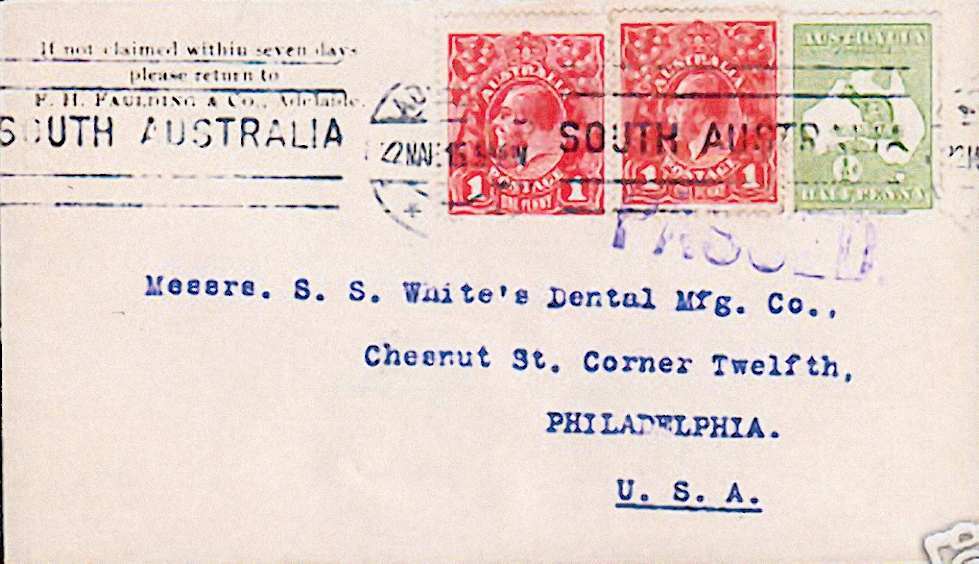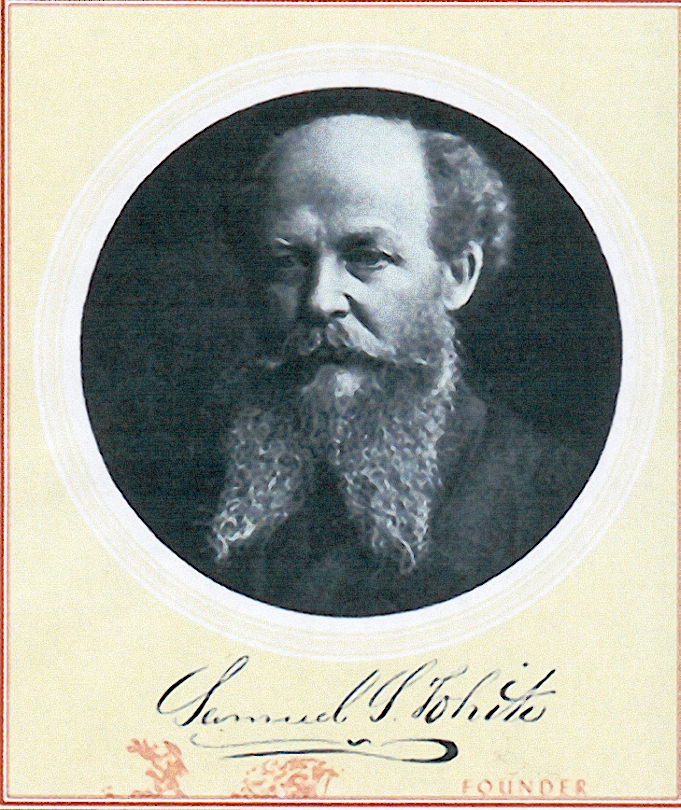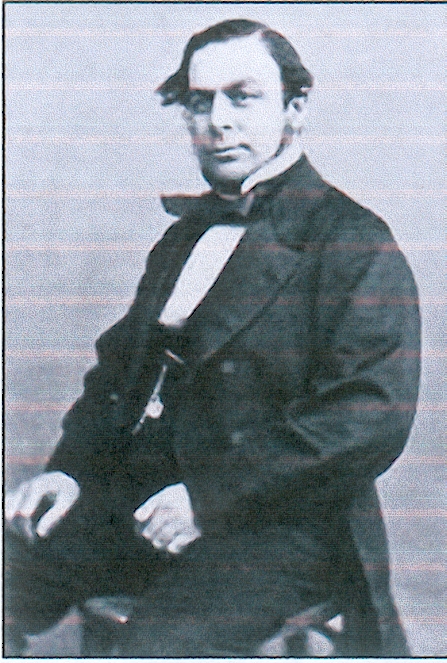The cover was sent from F.H. Faulding & Co., Adelaide to Messrs. S.S. White’s Dental Mfg. Co., Chestnut St. Corner Twelfth, Philadelphia, U.S.A. and the two red 1d KGV Head stamps and the green ½d ‘Roo on Map of Australia’ stamp were canceled with an ADELAIDE/ 22 MAR 15 5.45 PM SOUTH AUSTRALIA roller cancel. There was also a purple handstamp ‘PASSED’ (Figure 1).

S.S. White Technologies started life in Philadelphia some 162 years ago as a tooth factory founded by Dr. Samuel Stockton White in 1844 with a work force of three. Samuel Stockton White was born on June 19, 1822 to William Rose White and Mary Stockton in Hulmeville, Pennsylvania. By the age of 21 he was practicing dentistry in his uncle’s firm and supervising his manufacturing department. The next year, in 1844 young Samuel set up his own tooth factory in the attic of a house in downtown Philadelphia and practiced dentistry downstairs.
Samuel Stockton White’s little tooth factory became, over the decades, the largest dental manufacturing company in the world with sales offices in New York, Boston and Chicago, with catalogues in Spanish, French and German. Dr. White was a visionary and a tireless inventor with ten patents to his name. His products earned eighty medals for excellence from the great industrial institutes in the U.S. and were equally esteemed in Europe. He inspired creativity and initiative in his employees, such as Dr. Eli T. Starr (1834-1904) whose mechanical and inventive genius contributed most to the excellence of S.S. White Company. Dr. Starr had over a hundred patents to his name.
Dr. White was also an enlightened businessman. He employed a black chemist in his laboratory when blacks rarely found anything but menial jobs. His company published Dental Cosmos, a respected chronicle of dentistry, and it assumed a major role in educating other dentists. His classmate and later the personal dentist of Napoleon III of France, Dr. Thomas Evans introduced White’s innovative techniques in Europe.
During the Civil War, soldiers were required to have six upper and six lower teeth to bite off the end of a powder cartridge. Dr White led the American Dental Association and met with Abraham Lincoln with a proposal to provide dental services to the Union soldiers, though nothing came of it because of logistical issues.
Dr. White died of an attack of congestion of the brain on December 30, 1879 in Paris, France, at the age of fifty-seven. He was worth a million and a half dollars. He is one of the most revered names in the field of dentistry for transforming dentistry from a secretive trade into a respectable medical discipline. A signed picture of Samuel S. White, Founder is seen in Figure 2.

Dr. White’s grandson Samuel Stockton White III was a gymnast and an athlete. He joined the company in 1903 and became the Director in 1926. The company continued to flourishafter the original Dr. White’s death under a series of strong and creative managers, during the years 1881 through 1944. In 1881 it became a stock company. Its Flexible Shaft drill crossed over to other industrial applications and soon became a ubiquitous presence in daily American life, for in 1915, S.S. White Flexible Shafts replaced drive links in automobile speedometers. In 1937 it established a vast manufacturing plant in Staten Island, NY.
In 1941 the S.S. White company designed sophisticated Flexible Shaft assemblies for aircrafts of the U.S. military, and by 1950, S.S. White had become the largest employer in Staten Island, New York. In 1972, the S.S. White Industrial Division relocated to its current modern plant in Piscataway, New Jersey; completely severing its ties with its sister company, S. S. White Dental Manufacturing.
The sending company of the cover was founded by Francis Hardey Faulding, manufacturing chemist, who was born on 23 August 1816 and baptized at Swinefleet, Yorkshire, England, son of Francis Faulding, surgeon, and his wife Mary Ann. Influenced by his family environment and by the experimental work of Joseph Priestley (1733-1804), chemist and ‘discoverer’ of oxygen, young Faulding served an apprenticeship with his father and qualified as a chemist and surgeon. He sailed from Liverpool as a surgeon-superintendent in the emigrant ship Nabob and arrived at Sydney in February 1842. Seeking better opportunities he sailed in the Dorset for Adelaide, but found the economic slump deeper there than in Sydney. A photo of Francis Hardey Faulding is shown in Figure 3.

The above paragraph and Figure 3 are taken from a paper concerning F.H. Faulding and his company at this present website, in the category of Health Sciences. The information on S.S. White and his company was derived from the company’s website.